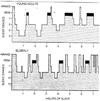Sleep complaints in community-living older persons: a multifactorial geriatric syndrome
- PMID: 17916123
- PMCID: PMC2785709
- DOI: 10.1111/j.1532-5415.2007.01399.x
Sleep complaints in community-living older persons: a multifactorial geriatric syndrome
Abstract
In older persons, sleep complaints in the form of insomnia and daytime drowsiness are highly prevalent and are associated with adverse outcomes. The underlying mechanisms are linked to age-related declines in physiology (normal aging) and age-related increases in disease prevalence (usual aging). This article describes how normal aging leads to less-restorative sleep, characterized by reductions in homeostatic and circadian sleep, and to phase advancement of the sleep-wake cycle, characterized by older persons being more alert in the early morning but drowsier in the early evening. It also describes how usual aging leads to sleep complaints through reductions in health status, loss of physical function, and primary sleep disorders. Psychosocial influences are likewise described, and their relevance to sleep complaints is discussed. These aging-related changes are subsequently incorporated into a conceptual model that describes sleep complaints as a consequence of multiple and interdependent predisposing, precipitating, and perpetuating factors, akin to a geriatric syndrome. The discussion concludes by applying the conceptual model to the sleep-related care of an older person with insomnia and daytime drowsiness and suggesting that the diagnostic assessment consider, in addition to primary sleep disorders, multiple domains, including medical, physical, cognitive, psychological, and social matters, with the intent of developing an overall therapeutic plan and establishing long-term follow-up.
Conflict of interest statement
The authors were involved in all aspects of this manuscript and report no conflicts of interest.
Figures



Comment in
-
Growing old should not mean sleeping poorly: recognizing and properly treating sleep disorders in older adults.J Am Geriatr Soc. 2007 Nov;55(11):1882-3. doi: 10.1111/j.1532-5415.2007.01401.x. J Am Geriatr Soc. 2007. PMID: 17979904 No abstract available.
-
Subjective sleep disturbances were closely associated with comprehensive geriatric functions in dose-responsive manner in the community-dwelling elderly people in Japan.J Am Geriatr Soc. 2008 Aug;56(8):1571-3. doi: 10.1111/j.1532-5415.2008.01761.x. J Am Geriatr Soc. 2008. PMID: 18808605 No abstract available.
References
-
- Institute of Medicine Report. Sleep disorders and sleep deprivation: an unmet public health problem. 2006. Apr [Accessed November 27, 2006]. At: www.iom.edu. - PubMed
-
- Foley DJ, Monjan AA, Brown SL, Simonsick EM, Wallace RB, Blazer DG. Sleep complaints among elderly persons: An epidemiologic study of three communities. Sleep. 1995;18:425–432. - PubMed
-
- National Sleep Foundation. Sleep in America Poll. 2003. [Accessed December 4, 2005]. At: www.sleepfoundation.org.
-
- Phillips B, Mannino D. Correlates of sleep complaints in adults: The ARIC study. J Clin Sleep Med. 2005;1:277–283. - PubMed
-
- Ohayon MM, Zulley J, Guilleminault C, Smirne S, Priest RG. How age and daytime activities are related to insomnia in the general population: Consequences for older people. J Am Geriatr Soc. 2001;49:360–366. - PubMed
Publication types
MeSH terms
Grants and funding
LinkOut - more resources
Full Text Sources
Medical

